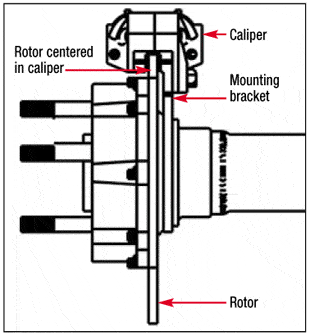Toll Free: 1-866-508-6394
OR Contact Us
OR Contact Us
Shop by Category
| One of the most important factors in the performance and subsequent service life of key disc brake components is proper alignment. If the caliper is offset in respect to the rotor position even slightly it will cause uneven pad wear —not to mention a decrease in stopping efficiency. This is one area that the engineers at Mark Williams Enterprises pay very close attention to when it comes to designing mounting brackets and hubs. When installing any disc brake you should be very attentive to the caliper/rotor relationship. There can be alignment problems caused by foreign matter, uneven fastener preload (which is a subject matter unto itself) and spacer issues. The goal, obviously, is to have the rotor centered perfectly between the caliper pads. You should also check rotor run-out by spinning the rotor with a dial indicator if possible. The maximum recommended run-out is .005/.008". Mark Williams Enterprises takes extra steps to ensure that its rotors are square and flat by incorporating the use of double disc grinding. This special machine grinds both sides of the rotor at the same time ensuring both rotor faces are parallel to one another. Rotors can become “cupped” or warped from excessive heat that’s often generated in severe high speed stops at a drag strip. To help overcome this, M-W has developed a rotor-mounting system called Slot Drive™. This system allows the rotor to expand from the heat and contract when it cools off. Benefits include improved braking efficiency and longer rotor life. Checking your rotors for flatness should be part of a routine maintenance inspection. Sometimes use of an incompatible pad (usually too soft) can result in deposits on the rotor, which can affect its flatness. Rotors can be re-machined, but like the brakes on your street machine, there’s a limit as to how far you can go. M-W recommends that no more than a total .030" be removed from the rotor, or approx 10% of its original thickness. Rotor surfacing should be done by M-W (due to additional machine work associated with the Slot Drive system). There are a number of choices when it comes to disc brake pads, but for a purpose-built race car the range is relatively narrow compared to a vehicle that will also be driven on the street. M-W employs a Ferodo Hi-Friction Lining for its standard caliper. They have proven to provide excellent stopping power and are engineered to minimize disc wear without losing its friction life characteristics. They are “bedded in” after one or two hard stops, but this will obviously vary from pad type to pad type. You’ll want to follow the break-in procedures as set forth by the brake lining manufacturer.  As for pad replacement, the general rule of thumb is that when a disc brake pad is 50% worn it should be replaced. DOT 4 (non-silicone) will also work fine for most drag applications. Changing the brake fluid annually is another well-founded recommendation. Using a pressure gauge to verify line pressure is another valuable tip. To be sure, reliable deceleration is just as important as acceleration —especially from a safety standpoint. Putting effort into properly setting up and maintaining your car’s brakes can prevent potentially dangerous situations. |
 |